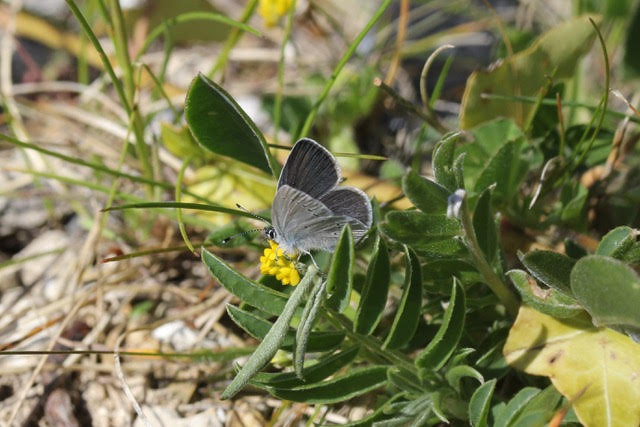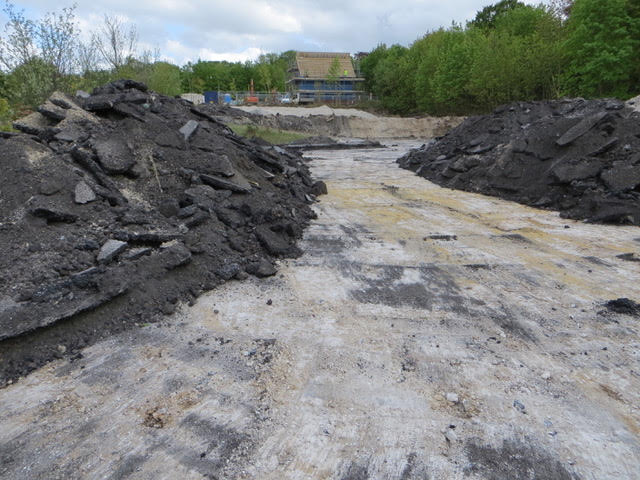 Abraham Lincoln
If given the truth, the people can be depended upon to meet any national crisis...
Abraham Lincoln
If given the truth, the people can be depended upon to meet any national crisis...
 Guildford news...
for Guildford people, brought to you by Guildford reporters - Guildford's own news service
Guildford news...
for Guildford people, brought to you by Guildford reporters - Guildford's own news service
Britain’s Most Bijou Butterfly Makes Comeback on North Downs
Published on: 28 May, 2020
Updated on: 30 May, 2020
Rising from the rubble of a derelict sports ground, Britain’s smallest butterfly, the small blue, is making a comeback at Surrey Wildlife Trust’s newest nature reserve, Priest Hill near Epsom, and across 20 sites in the North Downs between Guildford and Dorking.
Since 1979, the small blue has declined by 34% (UK Butterfly Monitoring Scheme 2018) across the UK, however at Priest Hill, the butterfly’s population has exploded from a count of zero to hundreds over recent years.
Just seven years ago the site was part of a housing development proposal for an abandoned sports ground, full of derelict buildings covered in graffiti and large areas of tarmac. But now, thanks to Surrey Wildlife Trust (SWT), the reserve has been transformed into a home for the small blue butterfly.
In 2013 the trust worked with developers of a small housing estate to include a new nature reserve as part of its proposal. The developer-funded the removal of thousands of tons of tarmac and rubble from the site, revealing a layer of chalk and the possibility of a new grassland habitat and wildflower nature reserve.
The small blue has a wingspan of just 20-30mm and despite the name, the butterfly’s upper wings are almost black in colour, with a delicate silvery-grey underwing. The butterfly lives and breeds on patches of sheltered chalk grassland where kidney vetch is found.
These yellow flowers are the only food the small blue caterpillar will eat. Developers continued to fund the Trust to manage the reserve and in 2014 SWT seeded the kidney vetch at Priest Hill from nearby Howell Hill nature reserve and since then, this tiny butterfly has gone from strength to strength.
Andrew Jamieson, project development manager at Surrey Wildlife Trust, said: “There were no small blue butterflies at Priest Hill in 2014, but during the regular monitoring carried out at the site, at least 10 were counted in 2016, around 78 the following year and by 2018 their numbers had exploded to 242.
“In 2019 112 small blue butterflies were counted on the reserve, but numbers do fluctuate from year to year and due to wet weather last June, they were down from 2018 but up from 2017. 2020 should be a bumper year as the weather is fine.
“Priest Hill is a phoenix from the flames success story and a really important reserve for creating green pathways for nature’s recovery across the landscape. It has transformed an area which used to attract antisocial behaviour into a wonderful nature reserve for local residents to enjoy.”
The success of the Small Blue at Priest Hill has also led to Surrey Wildlife Trust working with the wildlife charity Butterfly Conservation to support their Surrey Small Blue Stepping Stones project, which aims to boost the small blue butterfly numbers across the North Downs.
The two-year Butterfly Conservation project created butterfly habitat across 20 sites in the North Downs, including the SWT nature reserves West Hanger, Netley Plantation, Hackhurst Down, Brockham Quarry, Betchworth Quarry and Sheepleas.
Butterfly Conservation Project Officer, Fiona Haynes, said: “Working together is the best way to help this butterfly and Priest Hill is a fantastic reserve which is abundant with Kidney Vetch – the only food plant of the Small Blue caterpillar.
“Because of this, we used Priest Hill as a Kidney Vetch donor site and collected enough seed to use at 10 other locations between Guildford and Betchworth, which is amazing.
“While the Surrey Small Blue Stepping Stones project finished in July 2019, a dynamic group of butterfly conservation volunteers are still continuing the good work along the North Downs.”
Recent Articles
- City Succumbs to Penalty Equaliser in the Eleventh Minute of Stoppage Time
- Letter: Who Will Defend Guildford’s Allotment Holders?
- Updated: Accident Closes Portsmouth Road Diversion Route
- Upgrade for Spectrum Under Confirmed £10m Leisure Facility Contract
- The Ultimate Beatles Show – The ‘White Album’ On Stage, Note For Note
- Letter: Name-calling Won’t Solve GBC’s Housing Maintenance Issues
- Highways Bulletin: Smarter Traffic Lights, Smoother Journeys
- Birdwatcher’s Diary No.332
- Police Seek Information After Delivery Rider Assaulted
- Mayor’s Diary: August 3 – August 30



Search in Site
Media Gallery
Dragon Interview: Local Artist Leaves Her Mark At One of England’s Most Historic Buildings
January 21, 2023 / No Comment / Read MoreDragon Interview: Lib Dem Planning Chair: ‘Current Policy Doesn’t Work for Local People’
January 19, 2023 / No Comment / Read MoreA3 Tunnel in Guildford ‘Necessary’ for New Homes, Says Guildford’s MP
January 10, 2023 / No Comment / Read More‘Madness’ for London Road Scheme to Go Ahead Against ‘Huge Opposition’, Says SCC Leader
January 6, 2023 / No Comment / Read MoreCouncillor’s Son Starts Campaign for More Consultation on North Street Plan
December 30, 2022 / No Comment / Read MoreCounty Council Climbs Down Over London Road Works – Further ‘Engagement’ Period Announced
December 14, 2022 / No Comment / Read MoreDragon Interview: GBC Reaction to the Government’s Expected Decision to Relax Housing Targets
December 7, 2022 / No Comment / Read MoreHow Can Our Town Centre Businesses Recover? Watch the Shop Front Debate
May 18, 2020 / No Comment / Read More

















Recent Comments